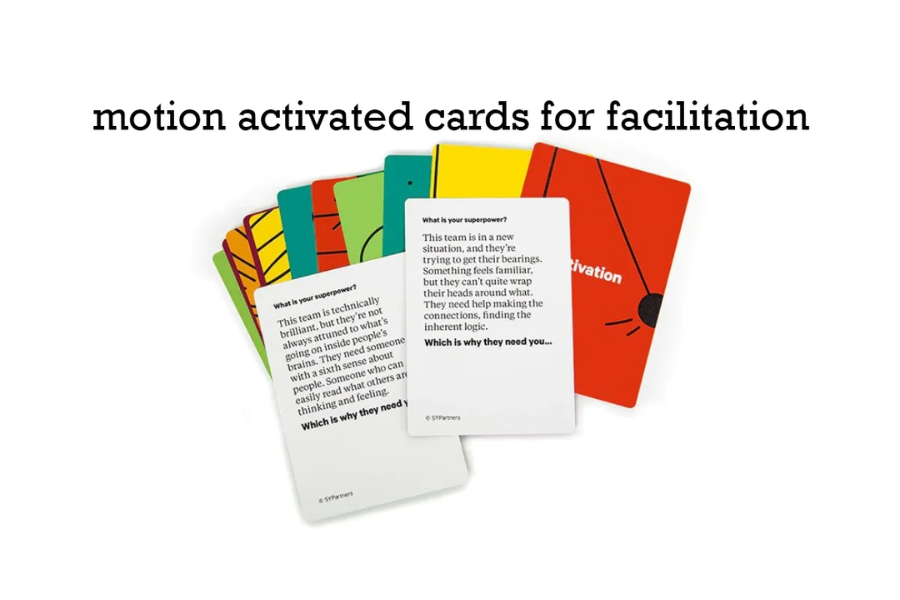In today’s rapidly evolving technological landscape, innovations continually reshape how we communicate and collaborate. Among these advancements,motion activated cards for facilitation have emerged as a groundbreaking tool, bridging the gap between traditional card formats and digital interaction. These cards exemplify how integrating modern technology with physical elements can transform communication and facilitation practices.
In this article, we will explore the benefits, drawbacks, and applications of motion-activated cards and how they are revolutionizing facilitation and interaction in various fields.
Understanding Dynamic Facilitation
Dynamic facilitation is a technique designed to help groups address complex issues and make creative decisions. Unlike traditional methods that rely on structured processes and predefined agendas, dynamic facilitation encourages a more fluid and open approach to problem-solving. This method empowers participants to explore multiple perspectives and arrive at innovative solutions, enhancing both personal and professional decision-making.
Demystifying Motion-Activated Cards
motion activated cards for facilitation are an innovative fusion of digital technology and physical cards. These cards incorporate electronic components and sensors that respond to specific movements, making them highly interactive. Typically, they feature:
Motion Sensors: The core component of these cards, motion sensors detect and respond to various movements. Common types include:
Gyroscopes: Track rotational movements and provide data on how the card is oriented.
Accelerometers: Measure direction, velocity, and detect shakes, tilts, and shifts.
Microprocessor/Motherboard: Acts as the control center, processing data from the sensors and executing commands. It essentially manages the card’s functions.
LEDs/Displays: Provide visual feedback or messages in response to motion. LEDs create an engaging interactive experience by illuminating or changing colors based on the card’s activity.
Power Source: Typically small batteries that power the card’s electronics. Despite their advanced features, these cards are designed to be energy-efficient.
Applications of Motion-Activated Cards
Motion-activated cards have a wide range of applications, enhancing interactions in various contexts:
Event Management: These cards can revolutionize events and conferences by:
Custom Interaction: Facilitators can use the cards to deliver personalized messages or instructions to attendees.
Networking: Attendees can exchange information seamlessly, enhancing networking opportunities and facilitating follow-up communications.
Educational Settings: Motion-activated cards can transform learning experiences by:
Engaging Tools: Trigger educational quizzes or interactive elements, making learning more dynamic an engaging.
Gamification: Incorporate game-like elements to make studying more enjoyable and interactive.
Corporate Events: These cards can make corporate training sessions more interactive by:
Training Simulations: Use motion-activated cards to create engaging training simulations, capturing attendees’ attention and enhancing learning retention.
Healthcare and Therapy: Improve patient experiences in medical settings by:
Interactive Alerts: Provide reminders for medication or routines, making patient interactions more engaging and less stressful.
Challenges and Considerations
Despite their potential, motion-activated cards face several challenges:
- Cost: Advanced technology can be expensive, though costs are expected to decrease as technology evolves and materials become more affordable.
- User Adaptation: Some individuals may need time to adjust to new methods of information sharing, posing a barrier to widespread adoption.
- Technical Issues: As with any technology, motion-activated cards are subject to potential malfunctions. Continued advancements and improvements are needed to enhance reliability.
- Privacy Concerns: The tracking capabilities of motion-activated cards may raise privacy issues. Implementing options to disable real-time tracking can address these concerns.
Final Thoughts
motion activated cards for facilitation represent a significant leap forward in technology, offering a new way to enhance communication and interaction. While there are challenges to overcome, the potential benefits for event management, education, corporate training, and healthcare are substantial. As technology continues to advance, motion-activated cards are poised to become an integral part of modern facilitation, providing innovative solutions for a range of applications. If you’re involved in any of these fields, embracing this technology could greatly enhance your engagement and communication strategies.
Discover the latest trends and in-depth insights at Craze Insider.
